[Editor’s Note: Since its inception last November, the Mad Scientist Laboratory has enabled us to expand our reach and engage global innovators from across industry, academia, and the Government regarding emergent disruptive technologies and their individual and convergent impacts on the future of warfare. For perspective, our blog has accrued almost 60K views by over 30K visitors from around the world!
Our Mad Scientist Community of Action continues to grow — in no small part due to the many guest bloggers who have shared their provocative, insightful, and occasionally disturbing visions of the future. Almost half (36 out of 81) of the blog posts published have been submitted by guest bloggers. We challenge you to contribute your ideas!
In particular, we would like to recognize Mad Scientist Mr. Sam Bendett by re-posting his submission entitled “Russian Ground Battlefield Robots: A Candid Evaluation and Ways Forward,” originally published on 25 June 2018. This post generated a record number of visits and views during the past six month period. Consequently, we hereby declare Sam to be the Mad Scientist Laboratory’s “Maddest” Guest Blogger! for the latter half of FY18. In recognition of his achievement, Sam will receive much coveted Mad Scientist swag.
While Sam’s post revealed the many challenges Russia has experienced in combat testing the Uran-9 Unmanned Ground Vehicle (UGV) in Syria, it is important to note that Russia has designed, prototyped, developed, and operationally tested this system in a combat environment, demonstrating a disciplined and proactive approach to innovation. Russia is learning how to integrate robotic lethal ground combat systems….
Enjoy re-visiting Sam’s informative post below, noting that many of the embedded links are best accessed using non-DoD networks.]

Russia, like many other nations, is investing in the development of various unmanned military systems. The Russian defense establishment sees such systems as mission multipliers, highlighting two major advantages: saving soldiers’ lives and making military missions more effective. In this context, Russian developments are similar to those taking place around the world. Various militaries are fielding unmanned systems for surveillance, intelligence, logistics, or attack missions to make their forces or campaigns more effective. In fact, the Russian military has been successfully using Unmanned Aerial Vehicles (UAVs) in training and combat since 2013. It has used them with great effect in Syria, where these UAVs flew more mission hours than manned aircraft in various Intelligence, Surveillance, and Reconnaissance (ISR) roles.
Russia is also busy designing and testing many unmanned maritime and ground vehicles for various missions with diverse payloads. To underscore the significance of this emerging technology for the nation’s armed forces, Russian Defense Minister Sergei Shoigu recently stated that the serial production of ground combat robots for the military “may start already this year.”
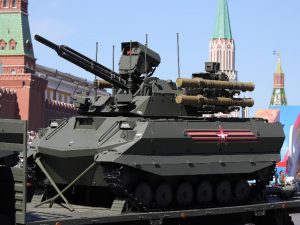
But before we see swarms of ground combat robots with red stars emblazoned on them, the Russian military will put these weapons through rigorous testing in order to determine if they can correspond to battlefield realities. Russian military manufacturers and contractors are not that different from their American counterparts in sometimes talking up the capabilities of their creations, seeking to create the demand for their newest achievement before there is proof that such technology can stand up to harsh battlefield conditions. It is for this reason that the Russian Ministry of Defense (MOD) finally established several centers such as Main Research and Testing Center of Robotics, tasked with working alongside the defense-industrial sector to create unmanned military technology standards and better communicate warfighters’ needs. The MOD is also running conferences such as the annual “Robotization of the Armed Forces” that bring together military and industry decision-makers for a better dialogue on the development, growth, and evolution of the nation’s unmanned military systems.
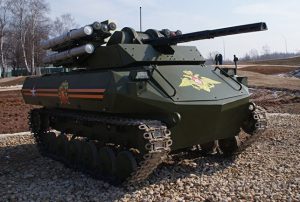
This brings us to one of the more interesting developments in Russian UGVs. Then Russian Deputy Defense Minister Borisov recently confirmed that the Uran-9 combat UGV was tested in Syria, which would be the first time this much-discussed system was put into combat. This particular UGV is supposed to operate in teams of three or four and is armed with a 30mm cannon and 7.62 mm machine guns, along with a variety of other weapons.
Just as importantly, it was designed to operate at a distance of up to three kilometers (3000 meters or about two miles) from its operator — a range that could be extended up to six kilometers for a team of these UGVs. This range is absolutely crucial for these machines, which must be operated remotely. Russian designers are developing operational electronics capable of rendering the Uran-9 more autonomous, thereby moving the operators to a safer distance from actual combat engagement. The size of a small tank, the Uran-9 impressed the international military community when first unveiled and it was definitely designed to survive battlefield realities….
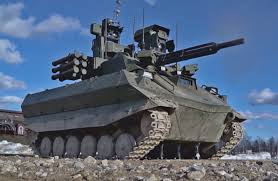
However, just as “no plan survives first contact with the enemy,” the Uran-9, though built to withstand punishment, came up short in its first trial run in Syria. In a candid admission, Andrei P. Anisimov, Senior Research Officer at the 3rd Central Research Institute of the Ministry of Defense, reported on the Uran-9’s critical combat deficiencies during the 10th All-Russian Scientific Conference entitled “Actual Problems of Defense and Security,” held in April 2018. In particular, the following issues came to light during testing:
• Instead of its intended range of several kilometers, the Uran-9 could only be operated at distance of “300-500 meters among low-rise buildings,” wiping out up to nine-tenths of its total operational range.
• There were “17 cases of short-term (up to one minute) and two cases of long-term (up to 1.5 hours) loss of Uran-9 control” recorded, which rendered this UGV practically useless on the battlefield.
• The UGV’s running gear had problems – there were issues with supporting and guiding rollers, as well as suspension springs.
• The electro-optic stations allowed for reconnaissance and identification of potential targets at a range of no more than two kilometers.
• The OCH-4 optical system did not allow for adequate detection of adversary’s optical and targeting devices and created multiple interferences in the test range’s ground and airspace.
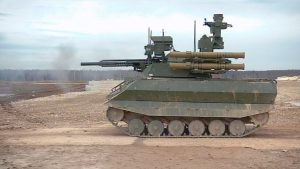
• Unstable operation of the UGV’s 30mm automatic cannon was recorded, with firing delays and failures. Moreover, the UGV could fire only when stationary, which basically wiped out its very purpose of combat “vehicle.”
• The Uran-9’s combat, ISR, and targeting weapons and mechanisms were also not stabilized.
On one hand, these many failures are a sign that this much–discussed and much-advertised machine is in need of significant upgrades, testing, and perhaps even a redesign before it gets put into another combat situation. The Russian military did say that it tested nearly 200 types of weapons in Syria, so putting the Uran-9 through its combat paces was a logical step in the long development of this particular UGV. If the Syrian trial was the first of its kind for this UGV, such significant technical glitches would not be surprising.
However, the MOD has been testing this Uran-9 for a while now, showing videos of this machine at a testing range, presumably in Russia. The truly unexpected issue arising during operations in Syria had to do with the failure of the Uran-9 to effectively engage targets with its cannon while in motion (along with a number of other issues). Still, perhaps many observers bought into the idea that this vehicle would perform as built – tracks, weapons, and all. A closer examination of the publicly-released testing video probably foretold some of the Syrian glitches – in this particular one, Uran-9 is shown firing its machine guns while moving, but its cannon was fired only when the vehicle was stationary. Another interesting aspect that is significant in hindsight is that the testing range in the video was a relatively open space – a large field with a few obstacles around, not the kind of complex terrain, dense urban environment encountered in Syria. While today’s and future battlefields will range greatly from open spaces to megacities, a vehicle like the Uran-9 would probably be expected to perform in all conditions. Unless, of course, Syrian tests would effectively limit its use in future combat.
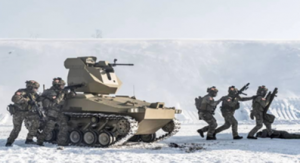
On another hand, so many failures at once point to much larger issues with the Russian development of combat UGVs, issues that Anisimov also discussed during his presentation. He highlighted the following technological aspects that are ubiquitous worldwide at this point in the global development of similar unmanned systems:
• Low level of current UGV autonomy;
• Low level of automation of command and control processes of UGV management, including repairs and maintenance;
• Low communication range, and;
• Problems associated with “friend or foe” target identification.
Judging from the Uran-9’s Syrian test, Anisimov made the following key conclusions which point to the potential trajectory of Russian combat UGV development – assuming that other unmanned systems may have similar issues when placed in a simulated (or real) combat environment:
• These types of UGVs are equipped with a variety of cameras and sensors — and since the operator is presumably located a safe distance from combat, he may have problems understanding, processing, and effectively responding to what is taking place with this UGV in real-time.
• For the next 10-15 years, unmanned military systems will be unable to effectively take part in combat, with Russians proposing to use them in storming stationary and well-defended targets (effectively giving such combat UGVs a kamikaze role).
• One-time and preferably stationary use of these UGVs would be more effective, with maintenance and repair crews close by.
• These UGVs should be used with other military formations in order to target and destroy fortified and firing enemy positions — but never on their own, since their breakdown would negatively impact the military mission.
The presentation proposed that some of the above-mentioned problems could be overcome by domestic developments in the following UGV technology and equipment areas:
• Creating secure communication channels;
• Building miniaturized hi-tech navigation systems with a high degree of autonomy, capable of operating with a loss of satellite navigation systems;
• Developing miniaturized and effective ISR components;
• Integrating automated command and control systems, and;
• Better optics, electronics and data processing systems.
 According to Anisimov’s report, the overall Russian UGV and unmanned military systems development arch is similar to the one proposed by the United States Army Capabilities Integration Center (ARCIC): the gradual development of systems capable of more autonomy on the battlefield, leading to “smart” robots capable of forming “mobile networks” and operating in swarm configurations. Such systems should be “multifunctional” and capable of being integrated into existing armed forces formations for various combat missions, as well as operate autonomously when needed. Finally, each military robot should be able to function within existing and future military technology and systems.
According to Anisimov’s report, the overall Russian UGV and unmanned military systems development arch is similar to the one proposed by the United States Army Capabilities Integration Center (ARCIC): the gradual development of systems capable of more autonomy on the battlefield, leading to “smart” robots capable of forming “mobile networks” and operating in swarm configurations. Such systems should be “multifunctional” and capable of being integrated into existing armed forces formations for various combat missions, as well as operate autonomously when needed. Finally, each military robot should be able to function within existing and future military technology and systems.
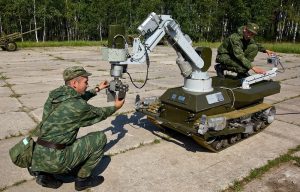
Such a candid review and critique of the Uran-9 in Syria, if true, may point to the Russian Ministry of Defense’s attitude towards its domestic manufacturers. The potential combat effectiveness of this UGV was advertised for the past two years, but its actual performance fell far short of expectations. It is a sign for developers of other Russian unmanned ground vehicles – like Soratnik, Vihr, and Nerehta — since it displays the full range of deficiencies that take place outside of well-managed testing ranges where such vehicles are currently undergoing evaluation. It also brought to light significant problems with ISR equipment — this type of technology is absolutely crucial to any unmanned system’s successful deployment, and its failures during Uran-9 tests exposed a serious combat weakness.
It is also a useful lesson for many other designers of domestic combat UGVs who are seeking to introduce similar systems into existing order of battle. It appears that the Uran-9’s full effectiveness can only be determined at a much later time if it can perform its mission autonomously in the rapidly-changing and complex battlefield environment. Fully autonomous operation so far eludes its Russian developers, who are nonetheless still working towards achieving such operational goals for their combat UGVs. Moreover, Russian deliberations on using their existing combat UGV platforms in one-time attack mode against fortified adversary positions or firing points, tracking closely with ways that Western military analysts are thinking that such weapons could be used in combat.
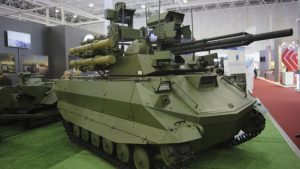
The Uran-9 is still a test bed and much has to take place before it could be successfully integrated into current Russian concept of operations. We could expect more eye-opening “lessons learned” from its and other UGVs potential deployment in combat. Given the rapid proliferation of unmanned and autonomous technology, we are already in the midst of a new arms race. Many states are now designing, building, exporting, or importing various technologies for their military and security forces.
To make matters more interesting, the Russians have been public with both their statements about new technology being tested and evaluated, and with the possible use of such weapons in current and future conflicts. There should be no strategic or tactical surprise when military robotics are finally encountered in future combat.

by djahal; Deviantart.com
For another perspective on Russian military innovation, please read Mr. Ray Finch’s guest post “The Tenth Man” — Russia’s Era Military Innovation Technopark.
Samuel Bendett is a Research Analyst at the CNA Corporation and a Russia Studies Fellow at the American Foreign Policy Council. He is an official Mad Scientist, having presented and been so proclaimed at a previous Mad Scientist Conference. The views expressed here are his own.



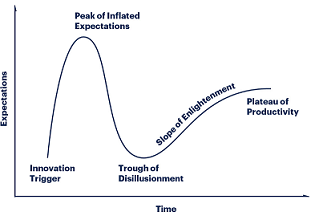




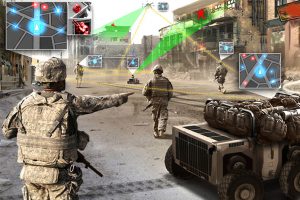 6. “
6. “